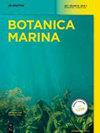crean湖大藻群落δ 13C、δ 15N稳定同位素值及其与峡湾沉积体系大藻有机碳来源的相关性
IF 1.4
4区 生物学
Q2 MARINE & FRESHWATER BIOLOGY
引用次数: 0
摘要
本文记录了苏格兰西部克雷兰湖(Loch Creran)大藻的同位素值,以确定配对稳定同位素分析在确定峡湾海湖中大藻衍生有机碳源中的适用性。岩藻和海带的同位素值(δ 13c和δ 15n)在重复水平和采样地点之间的个体菌体内具有明显的差异。在大型藻类的同位素值中,几乎没有一致的系统发育相关性。然而,δ 13c范围确实提供了更广泛的区分碳源的见解,例如陆地和海洋以及大型植物谱系之间的区别。因此,δ 13c可能表明有机物池中存在大藻碳源,但可能无法将这些碳源分离到较低的分类水平。因此,如果仅使用这些数据来区分大藻碳源及其对沉积池有机质的相对贡献,则很难得出准确的结论。本文提出的研究结果表明,需要补充技术或多示踪剂方法来帮助区分大藻碳源到较低的分类水平,而不是仅仅依靠稳定同位素作为生物标志物。本文章由计算机程序翻译,如有差异,请以英文原文为准。
Stable isotope values (δ 13C, δ 15N) of macroalgal communities at Loch Creran and its relevance for elucidating sources of macroalgal organic carbon in fjordic sedimentary systems
Abstract Here, macroalgal isotopic values from Loch Creran, Western Scotland, were documented to determine the suitability of paired stable isotope analysis for identifying macroalgal-derived organic carbon sources in a fjordic sea loch. Variability in isotopic values ( δ 13 C and δ 15 N) was evident within individual thalli of fucoid and kelp species, at the replicate level and between sampling localities. There were few consistent phylogenetic correlates in the isotopic values of macroalgae. The δ 13 C ranges did, however, provide insight into differentiating between carbon sources more broadly, such as terrestrial from marine and between macrophyte lineages. As such, δ 13 C could be indicative of the presence of macroalgal carbon sources within pools of organic matter but will likely be ineffective at separating these sources to lower taxonomic levels. Consequently, if these data are used alone to discriminate between macroalgal carbon sources and their relative contribution to a sedimentary pool of organic matter, the development of accurate conclusions will be challenging. The findings presented here demonstrate the need for complementary techniques or multi-tracer approaches to aid in the differentiation between macroalgal carbon sources to lower taxonomic levels rather than relying on stable isotopes as a biomarker alone.
求助全文
通过发布文献求助,成功后即可免费获取论文全文。
去求助
来源期刊

Botanica Marina
生物-海洋与淡水生物学
CiteScore
4.10
自引率
4.50%
发文量
43
期刊介绍:
Botanica Marina publishes high-quality contributions from all of the disciplines of marine botany at all levels of biological organisation from subcellular to ecosystem: chemistry and applications, genomics, physiology and ecology, phylogeny and biogeography. Research involving global or interdisciplinary interest is especially welcome. Applied science papers are appreciated, particularly when they illustrate the application of emerging conceptual issues or promote developing technologies. The journal invites state-of-the art reviews dealing with recent developments in marine botany.
 求助内容:
求助内容: 应助结果提醒方式:
应助结果提醒方式:


